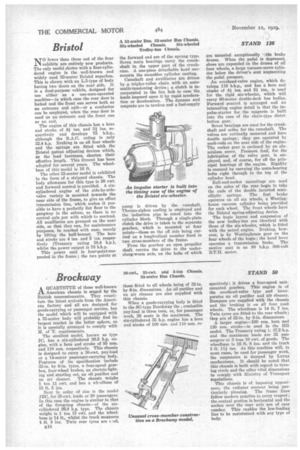Bristol
Page 156

If you've noticed an error in this article please click here to report it so we can fix it.
NO fewer than three out of the four exhibits are entirely lam products. The only model shown with a four-cylindared engine is the well-known and widely used 32-seater Bristol superbus. This is shown with an 14.5-type of body having two doors on the near side. It is a dual-purpose vehicle, designed for use either as a one-man-operated machine—in which case the rear door is locked and the front one serves both as an entrance and exit—or a conductor can be employed, when the rear door is used as an entrance and the front one as an exit.
The engine of this chassis has a bore and stroke of 41 ins. and 51 ins respectively and develops 75 b.h.p., although the R.A.C. rating is only 32.4 h.p. Braking is on all four wheels and the springs are fitted with the Bristol patent adjusting devices which, as the load increases, shorten their effective length. This fitment has been adopted for several years. The wheelbase of this model is 16 ft.
The other 32-seater model is exhibited in the form of a stripped chassis. The body allowance for this type is 30 cwt. and forward control is provided. A sixcylindered engine of the side-by-sidevalve variety is mounted towards the near side of the frame, to give an offset transmission line, which makes it possible to have a perfectly flat floor to the gangway in the saloon, as there is no central axle pot with which to contend. All auxiliaries are grouped on the near side, so that they can, for maintenance purposes, be reached with ease, merely by lifting the half-bonnet. The bore and stroke are 4 ins. end 5 ins. respectively (Treasury rating 38.4 h.p.), whilst the power output is 78 b.h.p.
This power unit is four-point-suspended in the frame ; the two points at the forward end are of the sprung type. Seven main bearings carry the crankshaft in the upper part of the crankcase, A one-piece detachable head surmounts the monobloc cylinder casting.
Camshaft and auxiliaries arc driven by a tripkx-roller chain with an automatic-tensioning device ; a clutch is incorporated in the fan hub to case the loads imposed upon it by rapid acceleration or deceleration. The dynamo and magneto are in tandem and a fuel-supply pump is driven by the camshaft. Termo-siphon cooling is employed and the induction pipe is cored into the cylinder block. Through a single-plate clutch the drive is taken to the separate gearbox, which is mounted at four points—those on the off side being carried on a longitudinal member fixed to two cross-members of the frame.
From the gearbox an open propeller shaft carries the drive to the underslung-worm axle, on the hubs of which are mounted exceptionally •7ide brake drums. When the pedal is depressed, shoes are expanded in the drums of all four wheels, a large vacuum-servo cylinder below the driver's seat augmenting the pedal pressure.
An overhead-valve engine, which develops 110 b.h.p., and has a bore and str.pke of 41 ins. and 5-} ins., is used for the rigid six-wheeler, which will carry 60-seater double-deck bus bodies. Forward control is arranged and an interesting engine detail is that the impulse-starter for the magneto is built into the case of the chain-type distribution gear.
Seven hearings are used for the crankshaft and seien for the camshaft. The valves are vertically mounted and have double springs; they are operated by push-rods on the near side of the engine. The rocker gear is enclosed by an aluminium cover. Pressure feed, for the lubrication of the valve gear, is employed, and, of course, for all the principal bearings of the engine. Rigidity Is ensured by carrying the main-bearing bolts right through to the top of the cylinder head.
Ball-and-socket mountings are used on the axles of the rear bogie to take the ends of the double inverted semielliptic springs. The foot brake operates on all six wheels, a Westinghouse vacuum cylieder belie, provided for each wheel. The front wheels have the Bristol spring-adjusting device.
The bogie layout and suspension of the new trolley-bus are identical with those of the six-wheeler, which is fitted with the petrol engine. Braking, however, is by Westinghouse gear on the four wheels of the bogie ; the hand lever operates a transmission brake. The motive unit is an 80 b.h.p. 500-volt B.T.H. motor.








































































































































































































































































































































